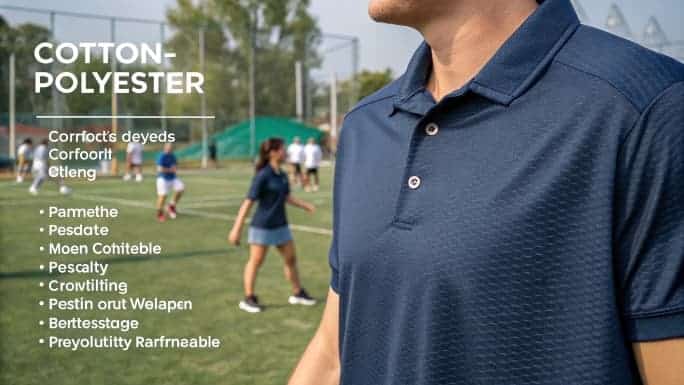
Choosing the right fabric for a polo shirt is essential for comfort, durability, and style. If you get it wrong, the shirt might not meet your expectations or your customers’ needs.
The best fabric for a polo shirt depends on your desired balance of comfort, durability, and style. Cotton, polyester, and fabric blends each have their unique advantages.
Let’s dive into the world of fabrics to help you make an informed decision for your next batch of custom polo shirts.
What Are the Advantages of Cotton Fabric1 for Polo Shirts?
Cotton is a classic fabric choice for polo shirts, but what makes it so popular?
Cotton offers softness, breathability, and comfort, making it ideal for casual wear and active lifestyles.

Dive Deeper: Why Cotton?
-
Softness: Cotton is naturally soft, which is why it’s so comfortable against the skin. It’s a great option for polo shirts meant for long wear.
-
Breathability: Cotton fabric is breathable, allowing air to circulate and preventing overheating. This is especially beneficial for active wearers.
-
Natural Feel: If you’re aiming for a classic, natural feel, cotton is the go-to choice.
Cotton Polo Shirt Characteristics
| Feature | Description |
|---|---|
| Comfort | Soft and gentle on the skin |
| Breathability | Great for warm weather |
| Eco-friendliness | Biodegradable and sustainable |
| Durability | Moderate wear and tear resistance |
Cotton polo shirts are perfect for brands focused on comfort and classic style.
How Does Polyester2 Compare to Cotton for Polo Shirt Fabric?
When choosing fabric for your polo shirts, polyester is another popular option. How does it compare to cotton?
Polyester is durable, moisture-wicking, and often more affordable than cotton. However, it lacks the natural feel that cotton offers.

Dive Deeper: Polyester Pros and Cons
-
Durability: Polyester is strong and resistant to wrinkles, stretching, and fading. It’s a durable option for polos that will see heavy use.
-
Moisture-Wicking: Unlike cotton, polyester pulls moisture away from the skin, making it ideal for activewear or hot climates.
-
Less Breathable: While polyester is moisture-wicking, it doesn’t allow air to flow as easily as cotton, which can lead to discomfort in hot weather.
Polyester vs. Cotton Comparison
| Feature | Cotton | Polyester |
|---|---|---|
| Comfort | Soft and breathable | Less breathable, smoother feel |
| Durability | Moderate | High |
| Moisture-Wicking | Low | High |
| Cost | Moderate to high | Low to moderate |
Polyester is a great option for sports teams or activewear brands looking for performance and durability at a lower price point.
What Is the Best Fabric Blend for a High-Quality Polo Shirt?
If you’re looking for the perfect balance between comfort, durability, and performance, fabric blends might be the way to go. What are the best blends for a high-quality polo shirt?
A cotton-polyester blend provides the best of both worlds: comfort from cotton and durability from polyester.

Dive Deeper: Exploring Fabric Blends3
Blends offer versatility by combining the strengths of different fibers. Here are some top blends for polo shirts:
-
Cotton-Polyester Blend (60/40): Offers comfort, breathability, and moisture-wicking properties while maintaining durability and affordability.
-
Cotton-Spandex Blend: Adds stretch for a more fitted, flexible feel while keeping the comfort and breathability of cotton.
-
Bamboo-Cotton Blend: Bamboo fiber adds natural antibacterial properties, making it an excellent choice for eco-friendly and performance-oriented polos.
Common Polo Shirt Blends
| Blend Type | Benefits | Ideal For |
|---|---|---|
| Cotton-Polyester | Comfortable, durable, moisture-wicking | Casual wear, performance wear |
| Cotton-Spandex | Stretchy, comfortable, flexible | Activewear, fitted designs |
| Bamboo-Cotton | Antibacterial, eco-friendly | Sustainable, performance wear |
Blended fabrics help brands tailor their polo shirts to specific needs, from performance to eco-friendliness.
What Fabric Is Most Durable for Long-Lasting Polo Shirts?
Durability is crucial for polo shirts that need to withstand frequent wear and washing. What’s the most durable fabric for long-lasting polos?
Polyester and polyester blends are the most durable options, offering resistance to shrinking, stretching, and fading.

Dive Deeper: Durability Factors
When it comes to durability, polyester and its blends stand out for several reasons:
-
Polyester: It’s resistant to wrinkles, shrinking, and fading, making it ideal for polo shirts that need to last long.
-
Cotton-Polyester Blends: Blends improve the strength of cotton and make polo shirts more resistant to wear and tear, without compromising comfort.
-
Reinforced Seams: To ensure longevity, many high-quality polo shirts feature double-stitched seams and reinforced collars.
Durability Breakdown
| Fabric Type | Durability | Best Use |
|---|---|---|
| Polyester | High durability, resistant to wear | Activewear, long-term use |
| Cotton-Polyester | Moderate to high durability | Casual, workwear |
| Bamboo-Cotton | Moderate durability | Eco-friendly options |
Durable fabrics like polyester blends are great for brands that prioritize longevity and strength.
How Do I Choose the Right Fabric for Custom Polo Shirts for My Brand?

Selecting the right fabric for your custom polo shirts can be a daunting task. How do you make the best choice for your brand?
Consider your target market, the type of polo shirt you need (casual or performance), and the quality expectations of your customers.
Dive Deeper: Factors to Consider
-
Target Audience: If your brand focuses on casual, everyday wear, cotton or cotton blends may be the way to go. For a more active or sports-oriented brand, polyester or a cotton-polyester blend would work better.
-
Purpose: Think about how the polo shirt will be used. Will it be worn in hot conditions? Look for moisture-wicking fabrics like polyester. Will it be worn in more casual settings? Opt for cotton or cotton blends.
-
Budget: While cotton is classic, polyester and blends often offer a more cost-effective solution without compromising too much on quality.
Choosing the Right Fabric for Your Brand
| Factor | Considerations | Ideal Fabrics |
|---|---|---|
| Target Audience | Casual or performance-focused? | Cotton for casual, Polyester for activewear |
| Intended Use | Daily wear or special occasions? | Cotton blends for everyday, Polyester for durability |
| Budget | Cost-effective or premium? | Blends for balance, Polyester for affordability |
Understanding your brand’s needs and your customers’ preferences will help you choose the perfect fabric for custom polo shirts.
Conclusion
The best fabric for your custom polo shirts depends on your brand’s focus—whether it’s comfort, durability, or performance. Cotton, polyester, and fabric blends each offer distinct advantages.
Footnotes
-
Cotton is a natural, breathable fabric that provides comfort and eco-friendliness, making it ideal for casual wear and active lifestyles. ↩
-
Polyester offers durability, moisture-wicking properties, and affordability, making it a top choice for performance and activewear brands. ↩
-
Fabric blends, such as cotton-polyester or cotton-spandex, offer a balance between comfort and durability, allowing for tailored solutions to meet specific needs. ↩



